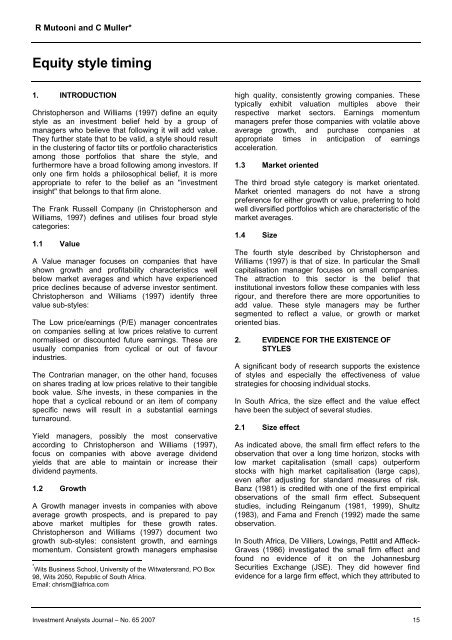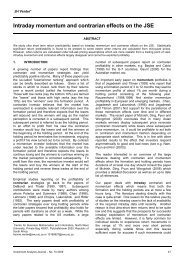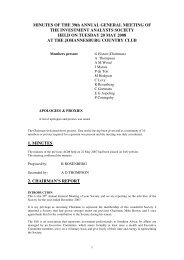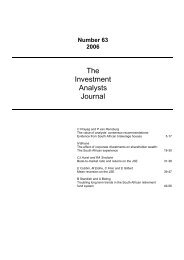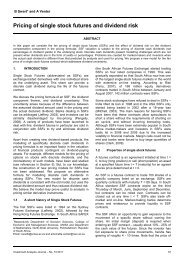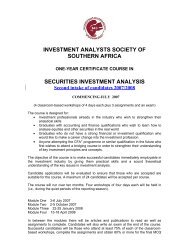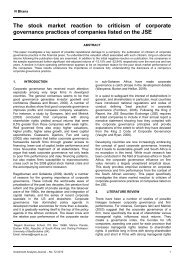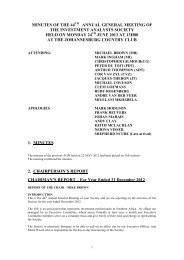Equity style timing - Investment Analysts Journal
Equity style timing - Investment Analysts Journal
Equity style timing - Investment Analysts Journal
You also want an ePaper? Increase the reach of your titles
YUMPU automatically turns print PDFs into web optimized ePapers that Google loves.
<strong>Equity</strong> R Mutooni <strong>style</strong> <strong>timing</strong> and C Muller*<br />
<strong>Equity</strong> <strong>style</strong> <strong>timing</strong><br />
1. INTRODUCTION *<br />
Christopherson and Williams (1997) define an equity<br />
<strong>style</strong> as an investment belief held by a group of<br />
managers who believe that following it will add value.<br />
They further state that to be valid, a <strong>style</strong> should result<br />
in the clustering of factor tilts or portfolio characteristics<br />
among those portfolios that share the <strong>style</strong>, and<br />
furthermore have a broad following among investors. If<br />
only one firm holds a philosophical belief, it is more<br />
appropriate to refer to the belief as an "investment<br />
insight" that belongs to that firm alone.<br />
The Frank Russell Company (in Christopherson and<br />
Williams, 1997) defines and utilises four broad <strong>style</strong><br />
categories:<br />
1.1 Value<br />
A Value manager focuses on companies that have<br />
shown growth and profitability characteristics well<br />
below market averages and which have experienced<br />
price declines because of adverse investor sentiment.<br />
Christopherson and Williams (1997) identify three<br />
value sub-<strong>style</strong>s:<br />
The Low price/earnings (P/E) manager concentrates<br />
on companies selling at low prices relative to current<br />
normalised or discounted future earnings. These are<br />
usually companies from cyclical or out of favour<br />
industries.<br />
The Contrarian manager, on the other hand, focuses<br />
on shares trading at low prices relative to their tangible<br />
book value. S/he invests, in these companies in the<br />
hope that a cyclical rebound or an item of company<br />
specific news will result in a substantial earnings<br />
turnaround.<br />
Yield managers, possibly the most conservative<br />
according to Christopherson and Williams (1997),<br />
focus on companies with above average dividend<br />
yields that are able to maintain or increase their<br />
dividend payments.<br />
1.2 Growth<br />
A Growth manager invests in companies with above<br />
average growth prospects, and is prepared to pay<br />
above market multiples for these growth rates.<br />
Christopherson and Williams (1997) document two<br />
growth sub-<strong>style</strong>s: consistent growth, and earnings<br />
momentum. Consistent growth managers emphasise<br />
* Wits Business School, University of the Witwatersrand, PO Box<br />
98, Wits 2050, Republic of South Africa.<br />
Email: chrism@iafrica.com<br />
high quality, consistently growing companies. These<br />
typically exhibit valuation multiples above their<br />
respective market sectors. Earnings momentum<br />
managers prefer those companies with volatile above<br />
average growth, and purchase companies at<br />
appropriate times in anticipation of earnings<br />
acceleration.<br />
1.3 Market oriented<br />
The third broad <strong>style</strong> category is market orientated.<br />
Market oriented managers do not have a strong<br />
preference for either growth or value, preferring to hold<br />
well diversified portfolios which are characteristic of the<br />
market averages.<br />
1.4 Size<br />
The fourth <strong>style</strong> described by Christopherson and<br />
Williams (1997) is that of size. In particular the Small<br />
capitalisation manager focuses on small companies.<br />
The attraction to this sector is the belief that<br />
institutional investors follow these companies with less<br />
rigour, and therefore there are more opportunities to<br />
add value. These <strong>style</strong> managers may be further<br />
segmented to reflect a value, or growth or market<br />
oriented bias.<br />
2. EVIDENCE FOR THE EXISTENCE OF<br />
STYLES<br />
A significant body of research supports the existence<br />
of <strong>style</strong>s and especially the effectiveness of value<br />
strategies for choosing individual stocks.<br />
In South Africa, the size effect and the value effect<br />
have been the subject of several studies.<br />
2.1 Size effect<br />
As indicated above, the small firm effect refers to the<br />
observation that over a long time horizon, stocks with<br />
low market capitalisation (small caps) outperform<br />
stocks with high market capitalisation (large caps),<br />
even after adjusting for standard measures of risk.<br />
Banz (1981) is credited with one of the first empirical<br />
observations of the small firm effect. Subsequent<br />
studies, including Reinganum (1981, 1999), Shultz<br />
(1983), and Fama and French (1992) made the same<br />
observation.<br />
In South Africa, De Villiers, Lowings, Pettit and Affleck-<br />
Graves (1986) investigated the small firm effect and<br />
found no evidence of it on the Johannesburg<br />
Securities Exchange (JSE). They did however find<br />
evidence for a large firm effect, which they attributed to<br />
<strong>Investment</strong> <strong>Analysts</strong> <strong>Journal</strong> – No. 65 2007 15
<strong>Equity</strong> <strong>style</strong> <strong>timing</strong><br />
the predominance of institutional investors and<br />
extensive cross holdings found in listed companies on<br />
the JSE. Similarly, Page and Palmer (1991) also found<br />
no evidence of a small firm effect on the JSE.<br />
Van Rensburg (2001) used a cluster analysis<br />
methodology to extract a parsimonious decomposition<br />
of <strong>style</strong> based effects on the JSE over the 16 year<br />
period to 1999. The results suggested three <strong>style</strong><br />
factors: value, size and earnings-momentum.<br />
Van Rensburg and Robertson (2003a) extended this<br />
research using a cross-sectional regression<br />
methodology (following Daniel and Titman (1997)) on<br />
share returns and <strong>style</strong> characteristics. In contrast to<br />
the earlier study they found no momentum effect, but<br />
did confirm significant size and value (P/E) effects.<br />
In a further study, Van Rensburg and Robertson<br />
(2003b) examined the explanatory power of size, value<br />
(P/E) and beta. They noted that many previous studies<br />
had failed to identify a size effect on account of small<br />
sample sizes. Using ten years of monthly data ending<br />
2000 and a two-way sorting procedure of quantile<br />
portfolios they presented evidence that small size<br />
earned a higher return on the JSE, but with a lower<br />
beta. They also reported similar findings for low P/E<br />
stocks.<br />
2.2 Value effect<br />
Graham and Dodd (1934) first advocated the efficacy<br />
of a value strategy whereby stocks, trading at a low<br />
price to book ratio have been observed to outperform,<br />
over the long term, those shares trading at<br />
comparatively higher ratios. Their approach was to<br />
look at how much capital a company had raised, and<br />
how much of its profits it had reinvested, and how<br />
much the company was willing to pay out as dividends.<br />
The first two measures combine to form the book value<br />
of the company, and the third its dividend payout ratio,<br />
all of which are components of 'value'.<br />
Several studies have documented a value effect<br />
including Basu (1983), Rosenberg, Reid and Lanstein<br />
(1985), De Bondt and Thaler (1985,1987), and Fama<br />
and French (1992, 1998).<br />
The seminal study of Fama and French (1998), for the<br />
period 1975-1995, showed that the difference between<br />
average returns on global portfolios of high and low<br />
book-to-market stocks was 7,6% per year, and value<br />
stocks out performed growth stocks in 12 of 13 major<br />
markets.<br />
Fama and French (1993, 1995, and 1998) showed that<br />
value stocks, defined as high book to market (B/M)<br />
stocks, have outperformed growth stocks over long<br />
periods of time. Capaul, Rowley and Sharpe (1993)<br />
also demonstrated this effect. Fama and French<br />
(1998) went on to show that the value premium also<br />
exists outside the USA. According to Black (1993)<br />
however, the value effect is sample specific, and is a<br />
chance result.<br />
Lakonishok, Shleifer and Vishny (1994) argued that<br />
the value premium arises because the market<br />
undervalues distressed stocks and overvalues growth<br />
stocks. Once these errors are corrected, value stocks<br />
have high returns and growth stocks have lower<br />
returns.<br />
In South Africa, Plaistow and Knight (1986) used 35<br />
JSE listed industrial shares and classified them as<br />
premium or discount shares depending on whether<br />
their Net asset value/ Market value was greater than or<br />
smaller than 1. They calculated the abnormal weekly<br />
returns for the year following the release of their<br />
annual report, and found that discount shares<br />
outperformed the premium shares over the year. They<br />
did not however ensure risk-adjusted returns for the<br />
portfolios.<br />
Bhana (1992) randomly selected 50 shares listed on<br />
the JSE, and ranked them into value and growth<br />
portfolios based on their Tobin’s Q ratio (defined as the<br />
ratio of the replacement value of assets to their market<br />
value). Tobin's Q is typically used as a measure of the<br />
excess economic value created by a company over the<br />
value of the assets. Bhana found a 6,4% annualised<br />
return differential in favour of the portfolio with the<br />
lowest Q value. Based on this result, he noted that the<br />
fact that a company creates economic value does not<br />
necessarily make its shares a good investment.<br />
Gates (1997) created annual value and growth<br />
portfolios using 100 randomly selected shares using<br />
annual rebalancing between 1986 and 1996. He found<br />
that portfolios with low Price/Book (P/B) ratios provided<br />
superior risk adjusted returns as compared to those<br />
portfolios with high P/B ratios.<br />
Van Rensburg (2002) observed that the two factor<br />
APT model needed to be augmented with measures of<br />
securities’ exposures to market capitalization,<br />
momentum, and value: he described these <strong>style</strong>s as<br />
additional axes of risk in the model.<br />
These findings, together with those of Van Rensburg<br />
noted earlier, present clear evidence of opportunities<br />
for <strong>style</strong> managers following both a size and/or value<br />
strategy.<br />
3. ECONOMICS OF STYLE INVESTING<br />
According to Bernstein (1995), the commodity bought<br />
and sold in the equities market is earnings growth.<br />
Investors will usually only invest in companies they<br />
believe will experience a growth of profits, which will<br />
significantly increase the share price. Those<br />
companies that can grow at a superior rate produce<br />
returns that will outperform the market, and those that<br />
16 <strong>Investment</strong> <strong>Analysts</strong> <strong>Journal</strong> – No. 65 2007
<strong>Equity</strong> <strong>style</strong> <strong>timing</strong><br />
do not will under-perform. Bernstein (1995) argues that<br />
if superior profit growth were to become scarce,<br />
investors would be willing to pay higher prices to<br />
obtain ownership in those select companies. If<br />
earnings growth were abundant, however, then<br />
investors would be less willing to pay high prices for<br />
growth shares. He further postulates that the<br />
abundance or scarcity of nominal earnings growth will<br />
affect how market segments, and investing <strong>style</strong>s,<br />
perform.<br />
What is important here is the concept of market <strong>timing</strong>.<br />
As the market moves through different phases<br />
Christopherson and Williams (1997) show that the risk<br />
for the value manager is in <strong>timing</strong> the purchase to<br />
capitalise on an expected price appreciation. For the<br />
growth manager, the risk lies in that the growth<br />
expected may not materialise. At times the market is<br />
better suited to a growth <strong>style</strong>, and at other times a<br />
value <strong>style</strong>.<br />
4. RESEARCH PROPOSITIONS<br />
Kao and Schumaker (1999) and Levis and Liodakis<br />
(1999) both contend that the <strong>style</strong> spreads, (the<br />
differential returns from investing in opposite ends of<br />
the <strong>style</strong> spectrum e.g. value against growth), are<br />
persistent and significant. This study pursues this<br />
idea, and three research propositions are considered:<br />
The market capitalisation effect occurs independently<br />
of the value effect.<br />
There are persistent, and significantly higher returns<br />
for <strong>style</strong> managers following a high price to book<br />
(growth) strategy compared with a low price to book<br />
(value) strategy.<br />
A strategy of <strong>timing</strong> the <strong>style</strong> turning points will outperform<br />
one of buying and holding the index.<br />
5. RESEARCH METHODOLOGY<br />
5.1 Overview<br />
A standard methodology for studying the value and<br />
market capitalisation effects has been established over<br />
time (e.g. Basu, 1977; De Villiers, Lowings and Affleck-<br />
Graves, 1986; Fama and French, 1992). This<br />
methodology is applied in this study.<br />
Portfolios of shares representing the cross sectional<br />
factors being investigated were created at the<br />
beginning of each year, starting in December 1986<br />
until May 2006, and their monthly total returns<br />
(including dividends) were calculated over the<br />
subsequent 12-month period. At the end of each 12-<br />
month period, the portfolios were reconstituted using a<br />
new sample of shares free of survivorship bias.<br />
To isolate the market capitalisation effect, the<br />
companies were ranked in descending order of market<br />
capitalisation. Those companies whose market value<br />
cumulatively made up the bottom 10% of this total<br />
capitalisation ranking constituted the small capportfolio.<br />
The next 10% of the total capitalisation<br />
constituted the mid-cap portfolio while companies in<br />
the top 80% constituted the large-cap portfolio.<br />
For the value effect, the shares were ranked in<br />
descending order of P/B ratio. The top 50% of the<br />
companies by number with the highest P/B ratio were<br />
placed in the growth portfolio, while the rest were<br />
placed in the value portfolio. Each share was therefore<br />
either in the growth portfolio or in the value portfolio.<br />
Portfolios were rebalanced annually.<br />
To define the twelve-month period, Fama and French<br />
(1997) used the December-to-December duration.<br />
Other researchers, e.g. Robins, Sandler and Durand<br />
(1999) used the November-to-November period. To<br />
prevent a look-ahead bias and ensure that only<br />
information available to investors at the time of<br />
portfolio formation was used, both the issued shares<br />
and P/B values were obtained from the previous year’s<br />
Annual Financial Statements.<br />
5.2 Population<br />
The population under consideration was that<br />
comprising all shares listed since 1986 on the<br />
Industrial sector of the JSE. As far as was possible,<br />
survivorship bias was avoided by including delisted<br />
shares. For unbundled shares, the new entities were<br />
treated as new listings, separate from the predecessor.<br />
For the reasons following, and to remain consistent<br />
with other South African studies (e.g. Robins, Sandler<br />
and Durand 1999, and Gates, 1987), this study<br />
excluded those shares listed on the mining sector, the<br />
financial sector, and all non main-board shares. The<br />
mining sector is highly dependent on the gold price<br />
(De Villiers, Lowings, Petit and Affleck-Graves 1986;<br />
Gates, 1987; Robins et al., 1999). Financial companies<br />
have a unique treatment of book value (Robins et al.,<br />
1999) and were excluded by Fama and French (1992).<br />
Non main-board companies tend to be very small, and<br />
highly illiquid. Limited research has been done on non<br />
main-board securities, and hence they may possess a<br />
large amount of non-systematic risk.<br />
5.3 Data<br />
Data for this study were obtained from the BFA-Net<br />
and I-NET online databases, while the JSE Monthly<br />
Bulletin was used to track name changes, corporate<br />
actions and de-listings.<br />
The study assumed that at portfolio formation, an<br />
investor was able to purchase shares at the closing<br />
price. These shares were then subsequently sold at<br />
<strong>Investment</strong> <strong>Analysts</strong> <strong>Journal</strong> – No. 65 2007 17
<strong>Equity</strong> <strong>style</strong> <strong>timing</strong><br />
the corresponding date twelve months later.<br />
Transaction costs, taxes, minimum block size<br />
requirements, impact cost and liquidity were not taken<br />
into account, as these factors were assumed to be<br />
relatively immaterial.<br />
5.4 Data integrity tests<br />
Both the BFA-NET and I-NET databases adjust data<br />
for share splits, consolidations and swaps. All the<br />
share price data was checked to ensure that this had<br />
been performed consistently. To confirm the accuracy<br />
of the data, an index comprising all the shares used<br />
each year was created. The returns from this index<br />
were plotted against the returns of the Industrial index.<br />
Since the population of (non-excluded) shares used in<br />
this study was the entire Industrial sector, whose index<br />
is the Industrial Index (J257), it was necessary to<br />
ensure that the share data closely tracked the index to<br />
confirm the reliability of the data.<br />
To ensure that all share splits and other actions were<br />
appropriately incorporated, a test was run to check<br />
whether any movement in share price in excess of<br />
40% month on month had occurred. A sample of such<br />
moves was examined and checked against corporate<br />
actions to ensure accuracy.<br />
If a share was de-listed during any twelve-month<br />
period, it was held in the portfolio until its last trading<br />
day, at which point the share was sold. For rights<br />
issues, a passive investment strategy was followed,<br />
therefore no rights were taken up; these were allowed<br />
to lapse.<br />
The book value was obtained from the BFA-NET<br />
database. It was calculated as ordinary capital plus<br />
distributable and non-distributable reserves, less the<br />
cost of control of subsidiaries and intangible assets.<br />
Where there were gaps in the data these were filled<br />
using FACtS Investors Guide.<br />
5.5 Portfolio return calculations<br />
For each portfolio, total monthly returns were<br />
calculated. Because it was not possible to identify the<br />
exact payment dates for dividends, it was assumed<br />
that they were received evenly during the year. Instead<br />
of using the actual dividend paid, Fama and French<br />
(1998) assumed that the dividend yield (defined as the<br />
trailing twelve-month dividend divided by the monthly<br />
closing price) would suffice in calculating total monthly<br />
returns. The annual dividend yield was accounted for<br />
as one-twelfth per month for the year. Compounding<br />
this monthly return reproduced the annual return. In<br />
using this method, they assumed that the capital gain<br />
component, measured monthly, accurately reproduced<br />
the volatility and covariance structure of total monthly<br />
returns.<br />
From each time series, cumulative monthly total<br />
returns were obtained in order to observe the total<br />
returns for the entire 20-year period.<br />
5.6 Prediction model<br />
An effective implementation of a <strong>style</strong> rotation strategy<br />
requires the development of a trading model to predict<br />
the appropriate switching events. Although not the<br />
main focus of this study, an attempt to construct an<br />
appropriate econometric model was made. In this<br />
context and following their rationale, the following<br />
macroeconomic variables identified by Kao and<br />
Shumaker (1999) and Levis and Liodakis (2000) were<br />
analysed:<br />
The (10 year vs 5 year) yield curve spread<br />
Corporate credit spread (AA vs BBB rated<br />
corporate bonds)<br />
Earnings yield gap (ALSI earning yield vs long<br />
bonds)<br />
The equity risk premium<br />
The inflation rate (historical CPI)<br />
The index of coincident economic indicators<br />
The rate of change of M3 money supply<br />
The return on the all share index<br />
The index of leading economic indicators<br />
A regression equation was constructed using the<br />
monthly return spread between value and growth<br />
portfolios as the dependent variable. To construct the<br />
model data from December 1986 to December 1993<br />
was used, so that the remaining data could be used to<br />
perform an out-of-sample test of the regression model.<br />
6. RESULTS<br />
Proposition 1: The market capitalisation effect<br />
occurs independently of the value effect.<br />
To test this proposition, the cumulative monthly returns<br />
obtained from the high price to book ratio (growth)<br />
portfolio were plotted together with those obtained<br />
from the low price to book ratio (value) portfolios. To<br />
ensure that the influence of size did not introduce bias<br />
into the result, this was conducted for both the large<br />
capitalisation and small capitalisation stocks<br />
independently.<br />
18 <strong>Investment</strong> <strong>Analysts</strong> <strong>Journal</strong> – No. 65 2007
<strong>Equity</strong> <strong>style</strong> <strong>timing</strong><br />
100<br />
5.0<br />
Small Value<br />
Small Growth<br />
Relative<br />
Small Value<br />
4.5<br />
4.0<br />
3.5<br />
10<br />
3.0<br />
Value of 1 Rand Invested<br />
1<br />
Relative<br />
Small Growth<br />
2.5<br />
2.0<br />
1.5<br />
1.0<br />
Relative<br />
0.5<br />
0.0<br />
-0.5<br />
0<br />
-1.0<br />
1986 1987 1988 1989 1990 1991 1992 1993 1994 1995 1996 1997 1998 1999 2000 2001 2002 2003 2004 2005 2006<br />
Figure 1: Value and growth in small cap stocks<br />
Figure 1 shows the returns of a small-cap growth portfolio and a small-cap value portfolio over the 20 years of the<br />
study. The relative performance of the two portfolios against each other reveals that there are periods of<br />
persistent out-performance for one or other strategy.<br />
100<br />
5.0<br />
Large Value<br />
4.5<br />
Large Growth<br />
4.0<br />
10<br />
Relative<br />
Large Value<br />
3.5<br />
3.0<br />
Value of 1 Rand Invested<br />
1<br />
Large Growth<br />
2.5<br />
2.0<br />
1.5<br />
1.0<br />
Relative<br />
Relative<br />
0.5<br />
0.0<br />
-0.5<br />
0<br />
-1.0<br />
1986 1987 1988 1989 1990 1991 1992 1993 1994 1995 1996 1997 1998 1999 2000 2001 2002 2003 2004 2005 2006<br />
Figure 2: Value and growth in large cap stocks<br />
Figure 2 shows the returns of a large-cap growth portfolio and a large-cap value portfolio over the 20 years of the<br />
study. The relative performance of the two portfolios against each other reveals that there are periods of<br />
persistent out-performance for one or other strategy – irrespective of company size.<br />
<strong>Investment</strong> <strong>Analysts</strong> <strong>Journal</strong> – No. 65 2007 19
<strong>Equity</strong> <strong>style</strong> <strong>timing</strong><br />
6.1 Value and growth: Small cap universe<br />
From Figure 1 above, five (including the start) turning<br />
points are evident from the relative performance graph.<br />
For the period from December 1986 to December<br />
1989, small cap value shares generally outperformed<br />
small cap growth shares. This trend was reversed until<br />
December 1992 when there was a cyclical shift into<br />
small cap value. This shift lasted until March 1994<br />
when growth came back into favour again. Growth<br />
continued to out perform value until November 1998<br />
when the cyclical shift again turned to value. From<br />
December 1998 to December 2002, however, value<br />
clearly outperformed growth, when the trend reversed<br />
before returning to favour value in August 2003.<br />
When examining only small cap shares, value and<br />
growth were profitable at different times over this<br />
period. Any investor able to consistently switch<br />
between the two, at the right time, would have outperformed<br />
an investor who bought and held small cap<br />
stocks.<br />
6.2 Value and growth: Large cap universe<br />
Figure 2 above shows the returns a <strong>style</strong> investor<br />
would have earned by investing only in large cap<br />
shares over the twenty-year period.<br />
Here the swings are less evident than in the small cap<br />
scenario, but no less dramatic. Starting in 1986, value<br />
was marginally ahead of growth, all the way to<br />
September 1991, when a definite shift out of value into<br />
growth occurred. This persisted until December 1992,<br />
when value came again to the fore. The next shift into<br />
growth started in November 1994 and persisted until<br />
December 1997 when a movement into value<br />
emerged, dominating until March 2001, when growth<br />
took over the trend to the current time.<br />
6.3 Proposition 2: There are persistent, and<br />
significant higher returns for <strong>style</strong><br />
managers following a high price to book<br />
ratio (growth) strategy as opposed to a low<br />
price to book (value) strategy<br />
If an investor were to ignore the influence of size and<br />
concentrate on the value/growth swings, the profile<br />
would have been that in Figure 3.<br />
The two time series seem to track each other closely,<br />
however the relative return series tells a different story.<br />
For the period between December 1986 and August<br />
1991, value marginally outperformed growth. From<br />
August 1991, growth clearly out-performed value until<br />
a turning point in December 1992, which shifted<br />
sentiment back to value. This trend prevailed until<br />
December 1994 when growth again came into the fore.<br />
Growth predominated until 1997 and since then value<br />
appears to have returned to favour, peaking in<br />
September 2001, and January 2003. Subsequently, it<br />
appears that returns to growth marginally outpaced<br />
returns to value for the period to 2006<br />
6.4 Proposition 3: A strategy of <strong>timing</strong> the <strong>style</strong><br />
turning points will out perform one of<br />
buying and holding the index.<br />
The following scenarios were modelled in order to<br />
investigate the efficacy of various levels of predictive<br />
accuracy in switching between <strong>style</strong>s. In all of these<br />
scenarios, the switching frequency used was monthly,<br />
i.e., all decisions to switch were made at the beginning<br />
of each month.<br />
• Perfectly accurate<br />
The investor was able to correctly predict every<br />
time a shift from value to growth happened, and<br />
was able to shift funds into the right <strong>style</strong>. In order<br />
to test this it was assumed that each time a shift<br />
happened, the investor was able to get into the<br />
outperforming <strong>style</strong> on time, and out of the underperforming<br />
<strong>style</strong> simultaneously.<br />
• Highly accurate<br />
In this scenario the investor was able to predict<br />
only the major switches discussed above and was<br />
able to move into the outperforming <strong>style</strong> and out<br />
of the under-performing <strong>style</strong>.<br />
• Perfectly inaccurate<br />
The investor made the wrong switch each month.<br />
Figure 4 shows that an investor who was able to<br />
perfectly time the market would have obtained a return<br />
of 43% pa. One who was able to find only the five<br />
major turning points would still have realised a return<br />
of 26,3% pa. An unfortunate investor who switched<br />
incorrectly each time would have lost 5,2%pa. In<br />
contrast, an investor who opted to invest in the<br />
Industrial or All Share Index would have obtained a<br />
return of 13,5% pa and 12,8% pa respectively.<br />
Clearly, any model designed to time the turns would<br />
have value, but only if it out performed the benchmark<br />
index as shown in Table 1 below:<br />
6.5 A prediction model<br />
To test the practical viability of a market <strong>timing</strong> strategy<br />
for different <strong>style</strong>s, a prediction model is required.<br />
The prediction model should (parsimoniously) indicate<br />
appropriate switching points between <strong>style</strong>s over the<br />
19 year period.<br />
20 <strong>Investment</strong> <strong>Analysts</strong> <strong>Journal</strong> – No. 65 2007
<strong>Equity</strong> <strong>style</strong> <strong>timing</strong><br />
100<br />
5.0<br />
AllCaps Value<br />
AllCaps Growth<br />
Relative<br />
AllCaps Value<br />
4.5<br />
4.0<br />
3.5<br />
10<br />
3.0<br />
Value of 1 Rand Invested<br />
AllCaps Growth<br />
2.5<br />
2.0<br />
1.5<br />
Relative<br />
1<br />
1.0<br />
Relative<br />
0.5<br />
0.0<br />
-0.5<br />
0<br />
1986 1987 1988 1989 1990 1991 1992 1993 1994 1995 1996 1997 1998 1999 2000 2001 2002 2003 2004 2005 2006<br />
-1.0<br />
Figure 3: Value and growth across the market<br />
Figure 3 shows the returns of a growth portfolio and a value portfolio for all the shares in the sample over the 20<br />
years of the study. The relative performance of the two portfolios against each other reveals that there are periods<br />
of persistent out-performance for one or other strategy across the market.<br />
10000<br />
Perfect <strong>timing</strong><br />
1000<br />
Five switches<br />
Return to Industrials Index<br />
Return to All Share Index<br />
Worst <strong>timing</strong><br />
43.0%<br />
Value of 1 Rand invested<br />
100<br />
10<br />
71<br />
25.9%<br />
13.5%<br />
12.8%<br />
1<br />
-5.2%<br />
0<br />
1986 1987 1988 1989 1990 1991 1992 1993 1994 1995 1996 1997 1998 1999 2000 2001 2002 2003 2004 2005 2006<br />
Figure 4: Effect of predictive accuracy<br />
Figure 4 shows the returns from various market-<strong>timing</strong> strategies, switching between value and growth <strong>style</strong>s.<br />
Even a strategy which switches only five times (at the major turning points) significantly out-performs the indices.<br />
<strong>Investment</strong> <strong>Analysts</strong> <strong>Journal</strong> – No. 65 2007 21
<strong>Equity</strong> <strong>style</strong> <strong>timing</strong><br />
Table 1: Comparative returns from the various strategies<br />
Perfect<br />
5<br />
Switches<br />
All Value<br />
Random<br />
All<br />
Growth<br />
Return to<br />
ALL Share<br />
Return to<br />
Industrials<br />
Index<br />
5 Bad<br />
Switches<br />
Imperfect<br />
Perfect 0,0% 13,2% 20,9% 22,3% 28,1% 29,1% 29,2% 36,8% 54,9%<br />
5 Switches -11,7% 0,0% 6,8% 8,0% 13,1% 14,0% 14,1% 20,8% 36,8%<br />
All Value -17,3% -6,3% 0,0% 1,2% 6,0% 6,8% 6,8% 13,1% 28,1%<br />
Random -18,3% -7,4% -1,2% 0,0% 4,7% 5,5% 5,6% 11,8% 26,6%<br />
All Growth -22,0% -11,6% -5,7% -4,5% 0,0% 0,7% 0,8% 6,8% 20,9%<br />
Return to ALL Share -22,5% -12,3% -6,3% -5,2% -0,7% 0,0% 0,1% 6,0% 20,0%<br />
Return to Industrials Index -22,6% -12,3% -6,4% -5,3% -0,8% -0,1% 0,0% 5,9% 19,9%<br />
5 Bad Switches -26,9% -17,2% -11,6% -10,6% -6,3% -5,7% -5,6% 0,0% 13,2%<br />
Imperfect -35,4% -26,9% -22,0% -21,0% -17,3% -16,7% -16,6% -11,7% 0,0%<br />
For example, the 5 switches strategy outperformed the All Share Index by 14%pa<br />
In order to ensure the model had predictive power the<br />
variables were lagged for three months relative to the<br />
dependent variable (AllV/AllG). A correlation analysis<br />
of the variables indicated that only the term structure,<br />
co-incident indicator, and earnings yield gap added to<br />
the explanatory power of the equation (Table 2).<br />
Table 2: Regression statistics for a three variable model<br />
Multiple R 73%<br />
R square 53%<br />
Adjusted R square 52%<br />
Standard error 11%<br />
Observations 85,0<br />
ANOVA Df SS MS F<br />
Regression 3 1,11 0,37 31,03<br />
Residual 81 0,96 0,01<br />
Total 84 2,07<br />
Coefficients Standard<br />
Error<br />
t-Stat P-<br />
value<br />
Intercept 0,47 0,20 2,35 0,02<br />
Term structure -0,11 0,02 -,687 0,00<br />
Co-incident indicator 0,01 0,00 4,09 0,00<br />
Earnings yield gap -0,02 0,01 -2,10 0,04<br />
Table 2 shows the regression statistics for an<br />
econometric model with three independent variables<br />
(viz: the term structure, the co-incident indicator and<br />
the earnings yield gap) to predict <strong>style</strong> turning points.<br />
6.6 Testing the predictive power of the<br />
regression<br />
In order to test the predictive ability of the model, a<br />
trading strategy was designed and tested using the<br />
out-of-sample data. It was assumed that the investor<br />
was fully invested in value shares at the beginning, i.e.<br />
January 1994. Using monthly output from the model<br />
and to minimise transaction costs, the following trading<br />
strategy was tested: “Switch to growth if the model<br />
indicates that the value/growth variable would narrow<br />
over the next two consecutive months. If either one of<br />
the following months showed an increase in the<br />
variable, then no switch was made.”<br />
Table 3 below presents the results of the analysis:<br />
As indicated in Table 3, the cumulative return of the<br />
trading strategy was lower than that from the perfect<br />
<strong>timing</strong> example, but nevertheless outperformed the All<br />
Share Index, the Industrial Index and the passive<br />
strategies of remaining in either value or growth over<br />
the entire period.<br />
7. INTERPRETATION OF RESULTS<br />
Fama and French (1998) showed that the value<br />
premium is a global phenomenon. This research<br />
affirmed their findings by showing the differential<br />
returns to investing in the different <strong>style</strong>s over a 20-<br />
year period in South Africa.<br />
The research also mirrored the findings of Lakonishok<br />
et al. (1994), and Capaul et al. (1993) that the value<br />
<strong>style</strong> outperforms growth over long periods of time. In<br />
addition, it also showed that this outperformance was<br />
cyclical, with growth sometimes outperforming value.<br />
The influence of size was significant, as predicted by<br />
Reinganum (1999). However, it was evident that the<br />
value effect occurred across the size spectrum, thus<br />
disagreeing with Reinganum (1981) who found that the<br />
value effect was a manifestation of the market<br />
capitalisation effect.<br />
The findings corroborated Van Rensburg (2001), Van<br />
Rensburg and Robertson (2003a, 2003b), Plaistow<br />
and Knight (1986), and Gates (1997) who found<br />
evidence for the value effect in South Africa.<br />
In contrast, the research did not corroborate Robins et<br />
al. (1999) who found no evidence of either the market<br />
cap effect or the value effect.<br />
The benefits of <strong>style</strong> <strong>timing</strong> were evident in the<br />
research. Following Christopherson and Williams<br />
(1997), <strong>timing</strong> had an influence in determining the<br />
returns to the <strong>style</strong> manager: If the value manager<br />
buys a share too soon, s/he may have to endure an<br />
extended period of under-performance. The same<br />
problem applies to growth managers.<br />
22 <strong>Investment</strong> <strong>Analysts</strong> <strong>Journal</strong> – No. 65 2007
<strong>Equity</strong> <strong>style</strong> <strong>timing</strong><br />
Table 3: Comparative returns on out-of-sample data Dec 1993 to Feb 2006.<br />
Value Growth Strategy Perfect Imperfect C127 ALSI<br />
Timing Timing<br />
Monthly return 1,07% 0,52% 1,17% 2,38% -0,77% 0,53% 0,66%<br />
Annual return 17,26% 9,82% 18,22% 36,44% -10,46% 10,06% 12,01%<br />
13 year return 675% 307% 745% 4162% -27% 302% 432%<br />
Monthly Std Dev 5,49% 5,98% 5,73% 5,29% 5,80% 5,92% 5,94%<br />
Table 3 shows the comparative returns of the <strong>style</strong><br />
<strong>timing</strong> portfolios. The strategy using the econometric<br />
model (column 3) shows that it is possible to outperform<br />
the indices and the simple value and growth<br />
<strong>style</strong>s on a consistent basis.<br />
8. CONCLUSIONS<br />
The objective of this research was to investigate<br />
whether the <strong>style</strong> <strong>timing</strong> strategies could be profitable<br />
on the JSE Securities Exchange.<br />
During the 20-year period, 1986 to 2006, value stocks<br />
outperformed growth stocks across the size spectrum.<br />
An econometric model to predict <strong>style</strong> turning points<br />
showed that <strong>timing</strong> the <strong>style</strong> spreads was a potentially<br />
more profitable strategy than buying and holding the<br />
index or simple (fixed) <strong>style</strong> strategy.<br />
A limitation of this research was that transaction costs<br />
were not considered. As the number of switches<br />
increase, the costs would naturally increase.<br />
Nevertheless, it is believed that the conclusions<br />
reached gave a fair and general indication of the<br />
potential of <strong>style</strong> switching strategies.<br />
For fund managers, a strategy of monitoring <strong>style</strong><br />
shifts and then tilting the portfolio, would allow them<br />
not have to trade too often, and in this way minimise<br />
trading costs.<br />
The fundamental implication of these findings is that<br />
<strong>style</strong> <strong>timing</strong> can improve returns to investors. In<br />
addition, the research clearly shows that managers<br />
should be measured against their <strong>style</strong> benchmarks.<br />
Measuring managers by market aggregates can only<br />
encourage <strong>style</strong> drift, and <strong>style</strong> inconsistency.<br />
In agreement with Levis and Liodakis (1999) this<br />
research showed that <strong>style</strong> consistency may be<br />
prudent for very long investment horizons especially<br />
when investors have very strongly held views on the<br />
performance of any given <strong>style</strong>. Any shorter<br />
investment horizon would benefit from controlled <strong>style</strong><br />
rotation strategies.<br />
REFERENCES<br />
Banz RW. 1981. The relationship between return and<br />
market value of common stocks. <strong>Journal</strong> of Financial<br />
Economics, 9: 3-18.<br />
Basu S. 1983. The Relationship between earnings<br />
yield, market value and return for NYSE common<br />
stocks. <strong>Journal</strong> of Financial Economics, 12: 129-156.<br />
Basu S. 1977. The investment performance of<br />
common stocks in relation to their price-earnings<br />
ratios: A test of the efficient market hypothesis. <strong>Journal</strong><br />
of Finance, 32(3): 663-681.<br />
Bernstein R. 1995. Style investing. New York: John<br />
Wiley & Sons, Inc.<br />
Bhana N. 1992. An empirical relationship between<br />
company growth, and the market price of securities<br />
listed on the Johannesburg Stock Exchange. South<br />
African <strong>Journal</strong> of Business Management, 23(3/4): 63-<br />
68.<br />
Black F. 1993. Beta & return. <strong>Journal</strong> of Portfolio<br />
Management, 20: 8-18.<br />
Capaul C, Rowley I and Sharpe W. 1993. International<br />
value and growth stock returns. Financial <strong>Analysts</strong><br />
<strong>Journal</strong>, 49(1): 27-36.<br />
Christopherson JA and Williams CN. 1997. <strong>Equity</strong><br />
<strong>style</strong>: What it is and why it matters, in The Handbook<br />
of <strong>Equity</strong> Style Management, Fabozzi FJ (editor),<br />
Second Edition New Hope, PA: Frank Fabozzi &<br />
Associates.<br />
De Bondt WFM and Thaler RH. 1985. Does the stock<br />
market overreact? <strong>Journal</strong> of Finance, 40(3): 793-805.<br />
De Bondt WFM and Thaler RH. 1987. Further<br />
evidence on investor overreaction and stock market<br />
seasonality. <strong>Journal</strong> of Finance, 42(3): 557-581.<br />
De Villiers P, Lowings T, Petit T and Affleck-Graves J.<br />
1986. An investigation into the small firm effect on the<br />
Johannesburg Stock Exchange. South African <strong>Journal</strong><br />
of Business Management, 17(4):191-195.<br />
Fama E 1991. Efficient capital markets II. <strong>Journal</strong> of<br />
Finance, 46 (5): 1575-1617.<br />
<strong>Investment</strong> <strong>Analysts</strong> <strong>Journal</strong> – No. 65 2007 23
<strong>Equity</strong> <strong>style</strong> <strong>timing</strong><br />
Fama E and French K. 1992. The cross section of<br />
expected stock returns. <strong>Journal</strong> of Finance, 47(2): 427-<br />
465.<br />
Fama E and French K. 1993. Common risk factors in<br />
the returns of stocks and bonds. <strong>Journal</strong> of Financial<br />
Economics, 53: 427-465.<br />
Fama E and French K. 1995. Size and book to market<br />
factors in earnings and returns. <strong>Journal</strong> of Finance,<br />
50(1): 131-155.<br />
Fama E and French K. 1998. Value versus growth:<br />
The international evidence. <strong>Journal</strong> of Finance, 53(6):<br />
1975-1999.<br />
Gates SR. 1997. The market to book effect on the<br />
Johannesburg Stock Exchange. Unpublished MBA<br />
Research Report, Johannesburg: University of the<br />
Witwatersrand.<br />
Rosenberg B Reid K and Lanstein R. 1985.<br />
Persuasive evidence of market inefficiency. <strong>Journal</strong> of<br />
Portfolio Management, 11: 9-17.<br />
Shultz P. 1983. Transaction costs and the small firm<br />
effect – A comment. <strong>Journal</strong> of Financial Economics,<br />
3: 379-402.<br />
Van Rensburg P. 2001. A decomposition of <strong>style</strong>based<br />
risk on the JSE. <strong>Investment</strong>s <strong>Analysts</strong> <strong>Journal</strong>,<br />
54: 45-60.<br />
Van Rensburg P and Robertson M. 2003a. Style<br />
characteristics and the cross-section of JSE returns.<br />
<strong>Investment</strong>s <strong>Analysts</strong> <strong>Journal</strong>, 57: 1-10.<br />
Van Rensburg P and Robertson M. 2003b. Size, price<br />
to earnings and beta on the JSE. <strong>Investment</strong>s <strong>Analysts</strong><br />
<strong>Journal</strong>, 58: 1-11.<br />
Graham B and Dodd D. 1934. Security analysis. New<br />
York: McGraw Hill.<br />
Kao D and Shumaker R. 1999. <strong>Equity</strong> <strong>style</strong> <strong>timing</strong>.<br />
Financial <strong>Analysts</strong> <strong>Journal</strong>, January/February: 37-47.<br />
Lakonishok J Shleifer A and Vishny RW. 1994.<br />
Contrarian investment, extrapolation and Risk. <strong>Journal</strong><br />
of Finance, 49(5): 1541-1578.<br />
Levis M and Liodakis M. 1999. The profitability of <strong>style</strong><br />
rotation strategies in the United Kingdom. <strong>Journal</strong> of<br />
Portfolio Management, Fall: 73-86.<br />
Page MJ and Palmer F. 1991. The relationship<br />
between excess returns, firm size and earnings on the<br />
Johannesburg Stock Exchange: An empirical analysis.<br />
South African <strong>Journal</strong> of Business Management, 22(3):<br />
63-73.<br />
Plaistowe T and Knight RF. 1986. Premium to book<br />
value may be a contrary indicator. The <strong>Investment</strong><br />
<strong>Analysts</strong> <strong>Journal</strong>, 28: 35-39.<br />
Reinganum MR. 1981. Misspecification of capital asset<br />
pricing: Empirical anomalies based on earnings yield<br />
and market values. <strong>Journal</strong> of Financial Economics, 9:<br />
19-46.<br />
Reinganum MR. 1999. The significance of market<br />
capitalisation in portfolio management over time.<br />
<strong>Journal</strong> of Portfolio Management, Summer: 39-49.<br />
Robins E Sandler M and Durand F. 1999.<br />
Interrelationships between the January effect, market<br />
capitalisation and value investment strategies on the<br />
JSE. <strong>Investment</strong>s <strong>Analysts</strong> <strong>Journal</strong>, 50: 53-64.<br />
24 <strong>Investment</strong> <strong>Analysts</strong> <strong>Journal</strong> – No. 65 2007


